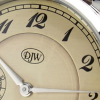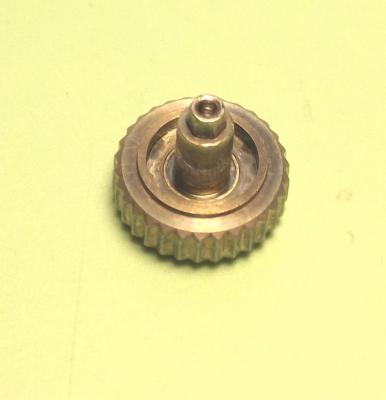Leaderboard
Popular Content
Showing content with the highest reputation on 04/23/16 in all areas
-
This website is now responsive. That means it will present itself differently depending on the size of the window. If your browser window is below a certain size then it will present as a tablet or mobile website. Maximise your browser window to full screen and refresh. I'm going to close this thread as the software upgrade happened quite a while back If you are still having problems please feel free to start a new thread or open a support ticket using the "support" link in the main menu above.2 points
-
Hi Alexander, IMHO: I've never had a case where the ultrasonic had broken any parts, eroded the finish yet (the baskets mainly). In my mind, that part was either already broken (maybe even glued together) or cracked which then it is understandable the ultrasonic worked its way into the already weak part. In either case, the part was already broken and not fit to be reused. All I can say is try and source another one as a replacement and soon the movement will be ticking away...with also a new hairspring? Best of luck, Cheers, Bob1 point
-
Yep pictures are a god send . You sort of learn with time what goes where but more complicated movements definitely need a pic or two or three .1 point
-
The best thing to do is contact as many material dealers as possible. Here is a good start: http://www.watchrepairtalk.com/links/watch-clock-repair-suppliers/ The Part number is 705 and the base calibre is 5001. I could not find one at Cousins or on Ebay. You could try May at Northern Watch & Clock Supplies - she often has long obsolete parts. https://www.linkedin.com/in/may-moorhead-69887b381 point
-
Hello from Sunny California. My name is Ryan and I am an amateur watchmaker/technician from Rancho Cordova, California. I've been interested in watches and analogue gauges for about as long as I can remember. One of my earliest memories is of the watch given to me by my grandparents when I was only two years of age. I can still remember the day it went missing- many tears were shed. It would be 36 years before I secured a replacement! Through the years I've had a number of watches- most quartz and never of high enough value to really warrant contracting with a watchmaker for service or repair. This past Christmas my wife gifted me with a vintage Breitling Navitimer. I had one before but we decided to part with it to help pay for our wedding. Ownership of a fine Swiss timepiece got me thinking about how to properly maintain the it and that's when I stumbled upon the Watch Repair Talk Forum and Mark's helpful videos. I suppose from that point I was hooked. I purchased George Daniels book and found myself riveted to every page. The next thing I knew I had invested in the tools of the trade and the rest is history! My hope is to parlay my experience as a hobbyist into a bonafide profession. I'll need the proper certifications to do so but from what I have read, I won't be ready for any exams until I have a bit of experience under the belt. I expect to be a regular on the forums here as this seems to be one of the best places I have found thus far for advice and guidance. I know there are many other amateurs on the forums here that have the same goal as I and information is shared quite freely and uncritically. So I would like to start my endeavor by thanking all the good people here for making the journey down this path everything but a lonely one! I'm sure it is with your assistance that success will be achieved. I am looking forward to sharing all my experiences (be them good and bad) here for support and guidance. Cheers!1 point
-
Hello Eric, Welcome to the forum from me in Wideopen. My tip is to take a pic before and after you remove each part from the watch - it is so much easier to put them back together if you have a reference point and you can always delete them if you dont want to keep them. Cheers, Vic1 point
-
Sexism aside... I use isopropyl alchol in an ultrasonic cleaner far away from my bench. I don't think I'm placing my health at risk.1 point
-
We get them from our parts department Seriously, I'm not sure of the cost mate. We charge it out as "Auto Calendar Service" which is a flat rate of AU$495.00 for any standard 3 hand automatic movement with a date complication. Sorry I can't be any more specific ... but you simply measure the arbor diameter (ID) and the broach you used to re-round the hole (OD) ... add a couple of thou to the OD for a press fit, and also check the ID for correct side-shake to get the correct jewel. Some plates require more broaching then others ... so the size you use can vary slightly for each movement. I'm sure Mark will make a step-by-step video on jeweling worn bushings one day and it will be all clear. It's not a difficult job with the correct tools.1 point
-
1 point
-
1 point
-
Ordered yesterday some Ni strips from China (usually i get my stuff from there for very cheap ). Till then started making NiCl from the remaining nickel coins submerged in the mixture of hydrochloric acid 50 mL (grocery 5-15%, more concentrated is faster) and hydrogen peroxide (35% from hairdressers shop) 20-30 mL. The solution was left outside overnight (~5 Celsius) and has nice green color now and the half of the coins are gone. It may be much faster with filed down Ni powder. I will get out the pieces and file them down. Ususally industry needs mirror finish right after the plating. They simply cant polish every piece. But for us and for 1-2 pieces... There is no need for complications for nickel plating on brass and copper. Simple NiCl solution is adequate. The surface will be semi-bright or matte but You can polish after. Tried it on some custom watch hands.1 point
-
@RyMoeller I hope the information here will benefit you as well There is more to come and hopefully forum member Szbalogh can help us out with some more DIY plating fluids. Depending on the donor-materials I get from forum member Ramrod, my plan was to make a walkthrough about watch-hands, watch-cases, main-plate & bridges and the crown itself. Submerged plating seems to be the most effective with good results, but it needs more complicated (expensive) fluids. Since I now finally received some pure-copper and pure-nickel, I like to try brush-plating as well (only suitable for small parts which can be totally covered by the sponge). The composition for the easy brush-plating electrolyte is further back in this thread. Lacking is the composition of the activator fluid......... All exciting stuff.......1 point
-
NO FAIR MARK!! You got a clean one. Why do I always get the barrels that look like they've been filled with Track-Roller Grease!1 point
-
@bobm12 Do women still wear them or is it just those little old ladies walking around down there that's throwing you off?1 point
-
I'm in the same boat myself....my bag of "small" watches is at least 10 lbs. Do you know what the heck we could do with these? lol, I was thinking of making something out of them but most are too small for anything:/1 point
-
Hi Micky, That's an interesting find...would it be some 2836 made by another company? i.e. could be a sellita or some similar...or even copied by the German company with some mods to accommodate the complications... It is really going to be an excellent post when you can report back with your findings...and looking forward to a walkthrough! Cheers, Bob1 point
-
1 point
-
Not a bad price its old but looks in good condition and not a bad price with a buy it now tag. http://www.ebay.co.uk/itm/VINTAGE-WATCH-MAKEER-JEWELRY-CLEANING-MACHINE-/1620463367391 point
-
1 point
-
Welcome Eric, hope you enjoy your new found hobby. You've come to the right place... should you need any help, just ask away. Buzz1 point
-
Welcome form me. I've got about 30 years experience as a watch and clockmaker.1 point
-
1 point
-
I didn't say I was an amateur "watch maker", I said I was an amateur "watchmaker". The space makes all the difference. And you clearly also didn't read my entire post, since I have done more than just repair watches. From various dictionaries (emphasis added by me): Merriam-Webster: one that makes or repairs watches or clocks. American Heritage: one that makes or repairs watches. Collins - (Horology) a person who makes or mends watches. Random House - a person whose occupation it is to make and repair watches Oxford - a person who makes and repairs watches and clocks. MacMillan - someone whose job is to make or repair watches Two thirds of the dictionaries say make "or" repair. Since you, nor anyone else for that matter, is the arbiter of what an English word means, those of us who repair watches are watchmakers, and those of us who do so for fun and without formal training are amateur watchmakers. But you can choose to use the "and" definition if you want, making all us except you "watchmakers".1 point
-
What ever you do don't touch the banking pins because if you do you will end up with all sorts of trouble. The first thing I would do is release all the power, remove the pallets, put a little power on and see if the train is free, make sure all the train has good endshake, inspect the pallets make sure the pallet stones are are set firm and pallet jewels are ok, put pallets in making sure the pallet bridge is fixed, add a little power and make sure the pallets are free up and down and have good endshake, now touch the pallets with your tweezers and see if the escape wheel will escape. Try that first and let me know.1 point
-
Absolutely love the use of the word "Ergo". Would have been better with the phrase "Ipso Facto"1 point
-
Ok, my take on it: This argument is basically splitting hairs! Here is the demonstration that "We are all watchmakers" We, people that work in watches are watchmakers since without us a watch simply doesn't exist. Let me explain: a true watch is supposed to give the time -- with more or less accuracy but decent time. A broken watch is inherently not a watch since it doesn't fulfill its original function: giving time. Forget all the complications and everything else. If it gives time it is either a watch or a clock...and some languages don't make that distinction by the way. So we will use the word watch for both. Object gives time = watch => watch exists. Object doesn't give time != watch => watch doesn't exist/not a watch, just a piece of junk/broken/garbage/something else/mother-in-law "personal" massager.... Now, (translating the above) if it is not giving time it is not a watch so if we fix it and MAKE it give time it becomes a watch or a clock, i.e. watch/clock exist. Ergo, we are all watchmakers. LQQD! Cheers, Bob1 point
-
Roger Smith? Agreed. It's what I was trying to express earlier, the term "Watchmaker" is a general term these days for someone who works on watches. Personally when someone asks me what I do, I say i'm a watchmaker and I quickly follow this with "But I don't actually make watches, I repair them". And as JDM says - it doesn't really matter. Yes, Roger Smith and his team could be classed as the only true Watchmakers in the UK in the sense that they manufacture and build watches. But that is using the word Watchmaker as a literal, in fact - in that sense is it really a word? It should be a phrase "watch maker", two words. The single word "Watchmaker" can also be an adopted word to describe a watch repairer - I have no problem with that. I was in Sainsbury's Butcher counter earlier, I didn't see much butchery going on - no blood on the floor, no carcasses on the bench being hacked to pieces. Might not be a brilliant analogy but hopefully you get my point.1 point
-
Well, it does Work! (thanks Rob for the tip!) After less than 3 days the stem is totally dissolved! There was a bit of black grit in the tube, but after a quick ultrasonic bath, the crown has no signs of the broken stem inside! The only noticeable affect on the crown is a slight darkening/staining of the surface. I'm not sure if this is a result of poor quality stainless steel(cheap Chinese reproduction) or if this will happen to any stainless steel. I d0 think I can clean the surface back to, or close to the original satin finish. One of my other concerns was that this crown has a spring inside to allow for a water-tight seal when the crown is seated home by use of the crown guard lever(remember it is a Panerai replica). As I cannot inspect the spring to check for damage, There does not appear to be any change to the spring strength itself. The process I used was to dissolve about a tablespoon amount of Alum in a small amount of water ( I will not attempt to explain the amounts further in metric or US measurements as I'm sure I will confuse everyone reading! :huh: ) and kept it heated by sitting it on a radiator/heater for the duration. I had to add water once as it will evaporate quickly under these conditions....1 point













